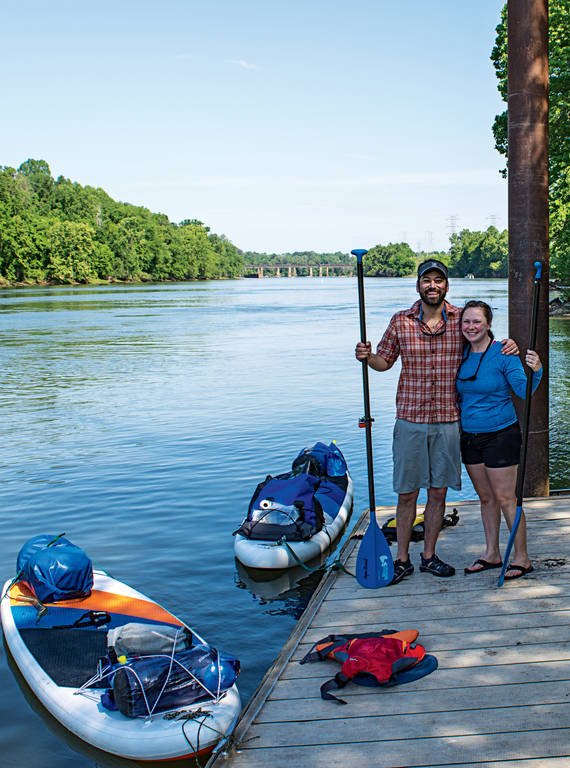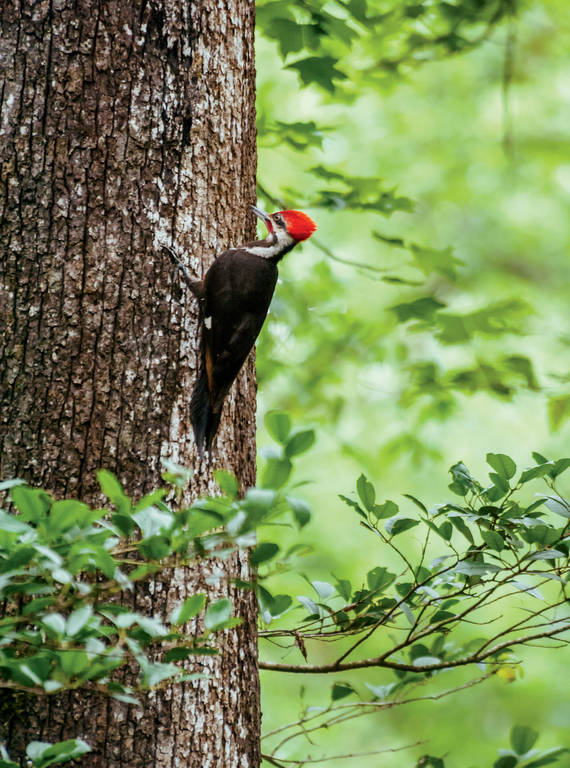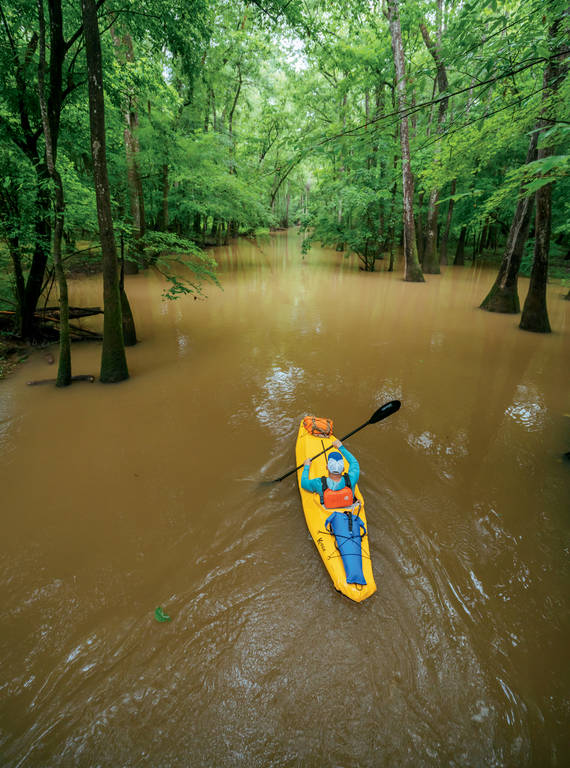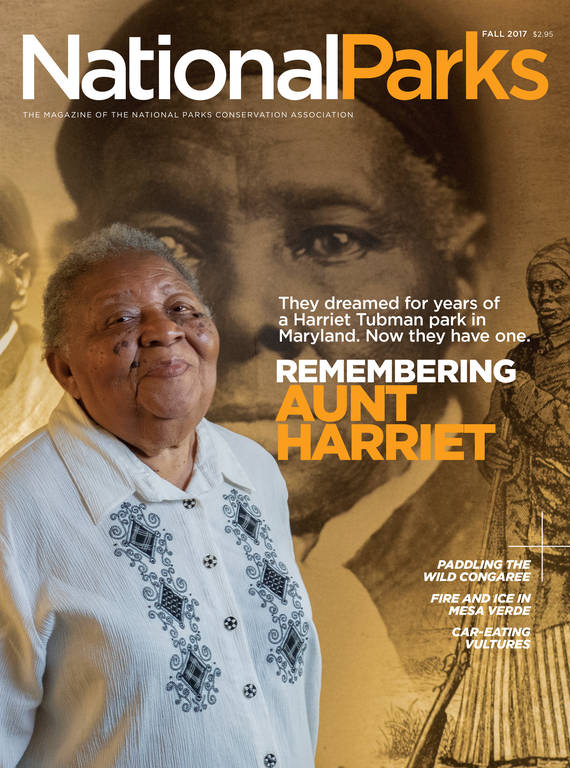Fall 2017
The Wild Congaree
Paddling the Blue Trail to South Carolina’s only national park.
“I’m scared,” Chrissy called out in the dark.
I could barely hear her over the rain pounding our small backpacking tent. Boom! Another massive crack of thunder shook the air above our little spit of sand.
“I am, too,” I said.
Lightning pulsed like a slow-motion strobe light, turning the tent a pale shade of blue every couple of seconds. Flash. Boom! Flash. Boom! Chrissy rolled over and reached out her hand. “No, I’m really scared. What if the river rises?”
“It won’t,” I said, even though I didn’t really know what would happen.
“Maybe we should pack up our gear, so we’re ready in case it does,” she said. The din of the storm made her voice sound small and distant.
“That’s a great idea.” At least it would give us something to do while we shuddered through the tempest. I unzipped the tent door, grabbed the sand-covered dry bags from the small vestibule and dragged them inside. Ten minutes later, the tent was clear except for our rain jackets, sleeping pads and one sleeping bag to share for the rest of the night.
With nothing else to do, we crouched on all fours on top of our sleeping pads. I vaguely remembered reading that that’s what you’re supposed to do if you’re caught in a lightning storm, but I was fuzzy on the details and wasn’t sure if we should be inside or outside the tent. We stayed in as violent gusts of wind shook the tent walls, bowing the poles and pulling the guylines from the sodden sand. My well-worn backpacking tent, which had faithfully kept us dry for more than a decade, was no match for this storm: Heavy, fat drops of water dripped onto the floor, worsening with each gust of wind. The lightning and thunder continued unrelentingly.
SIDE TRIP: COLUMBIA
“The only thing you have to worry about is sun poisoning,” Jesse Koch boomed, his deep voice softened by a South Carolina drawl. “Y’all got plenty of sunscreen?”
We did. And bug spray. And food. And water. And now, thanks to Koch, the gear shop manager, we had the paddles we needed and a shuttle driver to drive our rental car from the put-in to the take-out.
“All right then, y’all should be good to go. See ya Monday.”
It was three days before the tent-shaking thunderstorm. We’d arrived in Columbia, South Carolina’s capital, earlier in the day and had spent a couple of hours zipping here and there for provisions and last-minute items. Now that we’d connected with Koch, we were free to relax and enjoy the soft spring evening before our departure the next morning.
Our plan was simple: float 50 miles down the Congaree River from downtown Columbia to the southern edge of Congaree National Park, just 25 crow-miles away. We’d camp along the river for two nights and paddle for three days. I’d brought inflatable stand-up paddleboards for the trip, folding them into duffel bags already half-stuffed with the lightweight backpacking gear we’d need for the adventure. After 10 years of marriage to this self-proclaimed water rat and outdoor adventurer, Chrissy is a capable paddler and seasoned camper, but this was her first multiday stand-up paddleboard trip. And despite having completed a handful of long paddleboard trips in seasons past, it was my first real paddle of the year, so I was a bit nervous about how we’d do. But as we set off to find Motor Supply Company Bistro, the farm-to-table restaurant Koch had recommended, those worries drifted away.
The morning air was still cool when we reached the Rosewood Landing launch ramp. I unloaded the deflated boards and piles of gear onto the gravel parking lot. Factories and industrial development stretched back from the river toward the quiet neighborhoods we’d passed on our drive there. Chrissy inflated the boards with a small hand pump while I sorted gear and packed the dry bags. A kayaker carried his boat down the ramp and slipped out into the water, paddling upstream against the wide, slow river. Dogs played on the banks, leaping in and out of the water as their owners watched.

Moments before setting off on their 50-mile journey, the author and his wife pose for a photograph.
COURTESY OF GREG M. PETERSAt 11:02, we posed for a photo and stepped onto the boards. It felt great to be on the water. We live in Montana, where a long, cold winter had lingered into what should have been springtime, and we were starved for sunshine and heat. Smiling and optimistic, we dipped our paddles into the warm water and started downstream. After a mile, we saw a sign announcing the last public take-out for 47 miles. We paddled on.
The Congaree River is a short, winding ribbon of flat water that forms where the Saluda and Broad Rivers meet in Columbia. From there, it crosses the “fall line,” where the hills of the Carolina Piedmont transition to flat coastal plain. As the landscape shifts, the rushing river slows down and starts to meander through a huge floodplain just south of the city. Wet and swampy, the wide floodplain is relatively undeveloped, and at its far end lies Congaree National Park. South of the park, the Congaree River meets the Wateree and together, as the Santee River, they flow nearly 150 miles to the Atlantic Ocean.
We were following the Congaree River Blue Trail, a 50-mile water trail established in 2007 by a coalition of governmental agencies and advocacy groups, including American Rivers, to promote conservation and recreation on the river and in the park. A number of other similar blue trails wend their way across the country, and I stumbled across this one while researching a visit to the national park, which is what had initially drawn us to central South Carolina.

A pileated woodpecker.
© ADAM MOWERYFirst established as a monument in 1976, Congaree became a national park in 2003 and now extends across 27,000 acres, many of them trail-less wilderness. The park contains the largest remaining expanse of continuous old-growth bottomland hardwood forest in the country; massive trees, many the largest of their species, rise from the swampy landscape, nurtured by frequent flooding and nutrient-rich waters. Around 140,000 people visited Congaree in 2016, walking the 25 miles of trails, camping in one of the two campgrounds and standing in awe beneath some of the tallest trees in the country.
But I wanted a richer, more intimate experience — to camp in the wild floodplain and paddle the same waters that nourish the park’s famous trees and give life to its cacophonous birds. A springtime float along the river trail seemed the perfect option.
The wide brown river carried us gently downstream. Stubby, flat-bottomed skiffs zoomed up and down each side of the river, their small wakes rocking us as we bobbed along. Families fished beneath overhanging branches or lounged in thin strips of shade on sandbars where they had set up camp for the night. The upper river was busy, so we kept one eye on the passing boats and one on the river.
Despite the human traffic, wildlife buzzed on the river banks. We watched vultures glide from one bank to the other. A beaver waddled along a sandbar, awkward out of the water. Bright red cardinals flitted through the pistachio-colored willows. Turtles splashed off logs into the current if we paddled too close. Broad-leafed trees draped in thick curtains of invasive kudzu lined every inch of the banks. Rising 50 feet high in places, the vegetation felt like an impenetrable wall of green hemming us in.
We found an empty sandbar for our campsite and pulled off the river an hour before sunset. A slight breeze kept most of the mosquitoes at bay, and we set up camp accompanied by constant birdsong and the soft murmur of the river. We ate our freeze-dried backpacker meals — shepherd’s pie for me and vegetarian chili for Chrissy — and rested our tired muscles as the first planets appeared in the sky. The birds settled into their night’s repose. The sounds of peepers and bullfrogs filled the space between a barred owl’s otherworldly calls, growing louder as the Big Dipper, Leo and Virgo conjured themselves from the deepening darkness.
TRAVEL ESSENTIALS
Morning dawned gray and cool. The sky was unreadable, a white slab of marble that stretched from horizon to horizon. It was impossible to tell if the clouds were moving, never mind which way they might be going. We boiled water for instant coffee and ate our breakfast of dehydrated eggs mixed with Chrissy’s leftovers from the night before. Around 9 a.m., we pushed into the current and floated past a family fishing from a small skiff; they were the last people we would see until we finished the trip the next day. Even though we were only one day and 18 river miles or so from Columbia, the trip suddenly felt different, as if we had passed an imaginary line where civilization stopped and wilderness began. Our world collapsed into a tunnel of green zippered open by the slow-moving water.
Adding to the wild feel, the green wall of vegetation lining the river grew even thicker as we paddled. Only plastic bottles and other litter, swirling in eddies or corralled by logs, gave any hint that we were just downstream of hundreds of thousands of people. Great blue herons hunted fish and frogs from the banks, and ospreys soared above, their high-pitched cries shrill and clear. We drifted apart, each of us alone with our thoughts, absorbed by the rhythm of paddling and the subtle shifts of moving water under our feet. After a couple of hours, we paddled past the park boundary and found a spot to pull off the river and stretch our legs.
The trail, the only one that runs from Congaree’s visitor center to the river, was empty except for thick swarms of mosquitoes. We donned long-sleeved shirts and long pants and draped bandanas over our necks in an effort to keep them at bay. Movement was the only real solution, so we marched briskly along the path. The clouds thinned slightly and dappled light trickled through the bald cypress, laurel and live oak trees that rose tall from the leaf-covered ground. A quarter-mile from the river, we noticed a large pen, fenced with thick wire and sitting opposite a motion-triggered wildlife camera. A trapdoor, water trough and bait bag alluded to its purpose: catching the invasive feral hogs that root through the park, damaging sensitive vegetation, killing young trees and harming other animals.
About the Photographer
We stepped past the enclosure and kept going down the trail, half-hoping for a glimpse of the destructive interlopers. We turned around after about 90 minutes when a couple of massive trees blocked the path. Back on the boards, time passed almost imperceptibly as we paddled past acre after acre of parkland. Early afternoon drifted into evening and evening into dusk. After several attempts, we finally found a good campsite, hastily pitched the tent, secured our gear and boiled water for our meals. Thirty minutes after dark, we collapsed in the tent, ready for sleep. Two hours later, we were shoving gear into our dry bags as the lightning storm raged overhead.
It rained into the morning. Fortunately, the worst of the storm had blown past by 3 a.m., so we’d dozed for a few hours before the birds woke us at dawn. I felt sleepy when I was making the coffee, but I was also somehow energized and confident. I knew we’d face more wind, more rain and probably more lightning in the last 12 miles of the trip, but in the light of day, it all seemed totally doable, almost easy.

The Cedar Creek Canoe Trail winds through the park for around 15 miles before reaching the Congaree River.
© ADAM MOWERYBy the time we were back on the water, the rain had stopped. Life pulsated from the woods on both sides of the river. An intense rhythmic hum rose and fell, drowning out even the most vocal birds. We debated its source before realizing that thousands of frogs were joining in a wild chorus to celebrate the night’s storm. Mist drifted among the treetops, dark silhouettes against the pale gray sky. It felt as if we had traveled to a lost world.
When we rounded the final bend and glimpsed the bridge that marked our take-out, we hooted and hollered. Chrissy was excited for dry clothes and a shower. I was ready for a little civilization, too, but mostly, I wanted to relish our accomplishment. Here we were, just 25 miles from gleaming skyscrapers, fancy hotels and fantastic restaurants, and yet I’d found that wild, lightning-cracked experience that I’d come looking for. The trip was evidence that we don’t have to fly to exotic locations or spend two weeks backpacking through the Grand Canyon to feel the thrill of adventure and reap the hard-earned rewards that come when we take off into the unknown.

National Parks
You can read this and other stories about history, nature, culture, art, conservation, travel, science and more in National Parks magazine. Your tax-deductible membership donation of $25 or more entitles…
See more ›As we drove back to Columbia to meet Koch and turn in our paddles, we neared a sign marking the park’s official entrance. I tapped the brakes and fingered the blinker, debating whether to turn and pick up a shirt or patch to prove we’d been there. Glancing in the rearview mirror, I saw the mounds of wet, sand-covered gear piled in the back, and then I saw Chrissy, quiet and composed in the passenger seat, her hair tangled and beautiful. My thoughts drifted back over the previous three days — lightning bugs dancing in the forest under a canopy of shimmering stars, a water snake diving under the current not 10 feet from my board, giant trees towering above the empty trail.
I hit the gas and drove on.
About the author
-
 Greg M. Peters Contributor
Greg M. Peters ContributorGreg M. Peters writes from Missoula, Montana, where he finds plenty of adventures just dealing with regular life. Find his work at www.gregmpeters.com.


